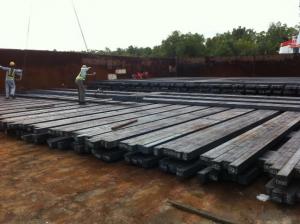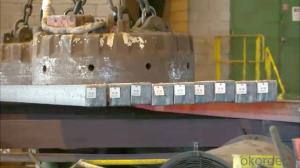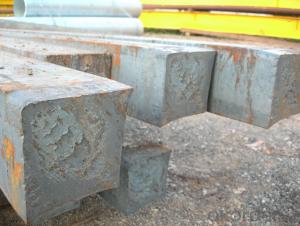Hot Rolled Square Steel Billet 3SP Standard 165mm
- Loading Port:
- Shanghai
- Payment Terms:
- TT OR LC
- Min Order Qty:
- 2000 m.t.
- Supply Capability:
- 10000 m.t./month
OKorder Service Pledge
OKorder Financial Service
You Might Also Like
Structure of Hot Rolled Square Steel Billet 3SP Standard 165mm

Description of Hot Rolled Square Steel Billet 3SP Standard 165mm
PPGI is made by cold rolled steel sheet and galvanized steel sheets as baseplate, through the surface pretreatment (degreasing, cleaning, chemical conversion processing), coated by the method of continuous coatings (roller coating method),
and after roasting and cooling. Zinc coating: Z60, Z80, Z100, Z120, Z180, Z275, G30, G60, G90
Alu-zinc coating: AZ60, AZ80, AZ100, AZ120, AZ180, G30, G60, G90
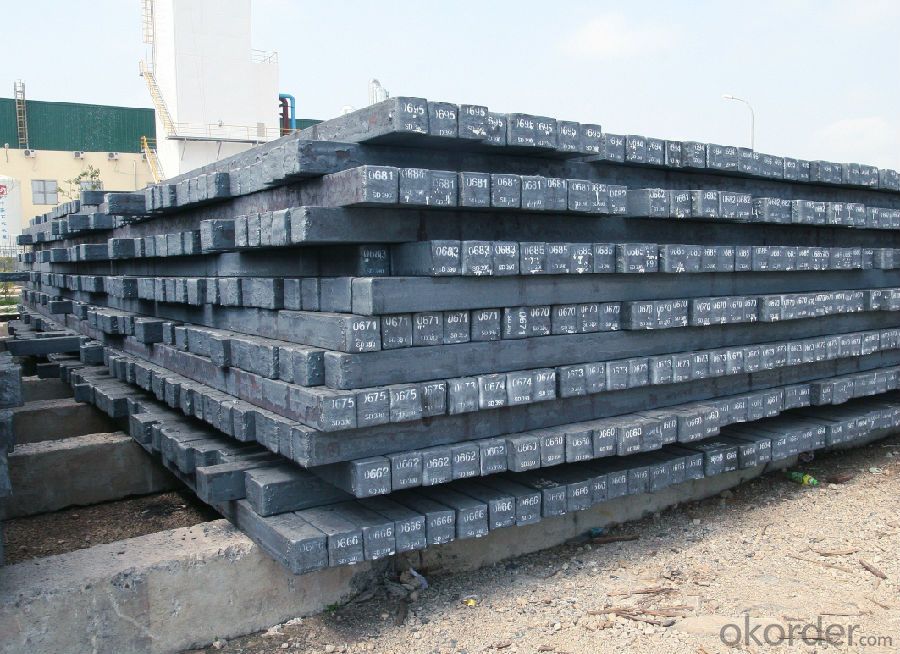
Main Feature of Hot Rolled Square Steel Billet 3SP Standard 165mm
1) Excellent corrosion resistance: The zinc layer provides a good protection of Pre-painted Galvanizeed Steel Sheet.
2) High heat resistance: The reflective surface of the material aids in efficiently reflecting the sunlight away and in turn reducing the amount of heat transmitted. The thermal reflectivity converts into energy savings.
3) Aesthetics: Pre-Painted Galvanized steel sheet is available in plethora of patterns and multiple sizes as per the requirements that given by our customers.
4) Versatility: can be used in the various areas.Standard seaworthy export packing: 3 layers of packing, inside is kraft paper, water plastic film is in the middle and outside GI steel sheet to be covered by steel strips with lock, with inner coil sleeve.
Applications of Hot Rolled Square Steel Billet 3SP Standard 165mm
1) Automotive bodies: filters, fuel tanks, etc.
2) Construction materials: roofings, welding pipes,
3) Electric and electronic appliances: computer cans, etc.
4) Steel cans: containers, etc.
5) Steel furniture: washing machines, refrigerators, microwaves, etc.
6) Drums
7) Office equipment: printer, recorders, etc.
8) Motors and transformers
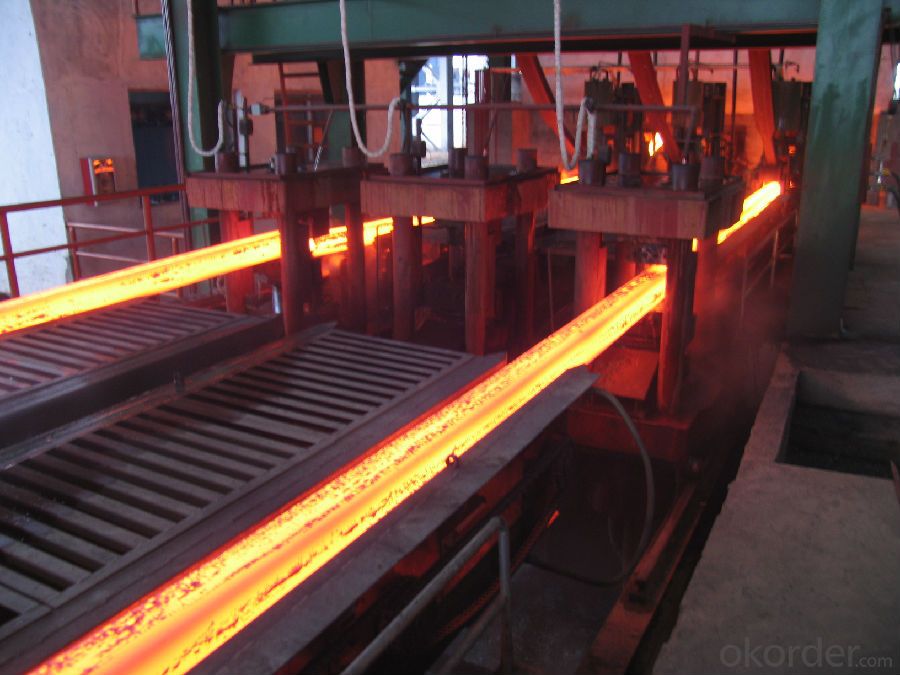
Specifications of Hot Rolled Square Steel Billet 3SP Standard 165mm
| Classified symbol | Yield Point Minimum N/mm2 | Tensile Strength Minimum | Elongation Minimum % | Application | ||||
| N/mm2 | Nominal Thickness mm (t) | |||||||
| JIS | Yogic | 0.25-0.4 | 0.4-0.6 | 0.6-1.0 | 1.0-1.6 | |||
| G3312 | specification | |||||||
| CGCC | CGCC | -205 | -270 | -20 | -21 | -24 | -24 | Commercial |
| CGCD | CGCD | --- | 270 | --- | 27 | 31 | 32 | Drawing |
| --- | CG340 | 245 | 340 | 20 | 20 | 20 | 20 | Structural |
| CGC400 | CG400 | 295 | 400 | 16 | 17 | 18 | 18 | Structural |
| CGC440 | CG440 | 335 | 440 | 14 | 15 | 16 | 18 | Structural |
| CGC490 | CG490 | 365 | 490 | 12 | 13 | 14 | 16 | Structural |
| CGC570 | CG570 | 560 | 570 | --- | --- | --- | --- | Structural |
| ASTM Designation | Yield Point Minimum | Tensile Strength Minimum | Elongation Minimum % | Application | Q/BQB 445-2004(China standard) | ASM A653/A653M | JISG 3312 | |
| ksi(MPa) | ksi(MPa) | TDC51D+Z | (CS TYPE A+Z) | CGCC | ||||
| A653(M)-99 CS TYPE A,B,C | --- | --- | --- | Commercial | TDC52D+Z | CGCD | ||
| A653(M)-99 FS | --- | --- | --- | Lock Forming | TS250GD+Z | (G250+Z) | - | |
| A653(M)-99 DS | --- | --- | --- | Drawing | TS300GS+Z | (G300+Z) | CGC 400 | |
| A653(M)-99 SS Grade33(230) | 33(230) | 45(310) | 20 | Structural | TS350GD+Z | (G350+Z) | CGC490 | |
| A653(M)-99 SS Grade37(255) | 37(255) | 52(360) | 18 | Structural | TS550GD+Z | (G550+Z) | CGC570 | |
| A653(M)-99 SS Grade40(275) | 40(275) | 55(380) | 16 | Structural | ||||
| A653(M)-99 SS Grade50(345) | 50(345) | 65(450) | 12 | Structural | ||||
| A653(M)-99 SS Grade80(550) | 80(550) | 82(570) | --- | Structural | ||||
FAQ of Hot Rolled Square Steel Billet 3SP Standard 165mm
We have organized several common questions for our clients,may help you sincerely:
1. How Can I Visit There?
Our company is located in Tianjin City, China, near Beijing. You can fly to Tianjin Airport Directly. All our clients, from home or aboard, are warmly welcome to visit us!
2. How Can I Get Some Sample?
We are honored to offer you sample.
3. Why choose CNBM?
1, ISO, BV, CE, SGS approved.
2, Competitive price and quality.
3, Efficient service team online for 24 hours.
4, Smooth production ability(50000tons/month) .
5, quick delivery and standard exporting package.
6, Flexible payment with T/T, L/C, Paypal, Kunlun bank, etc.
- Q:What are the different methods of steel billet surface grinding?
- There are several methods of steel billet surface grinding, including abrasive grinding, belt grinding, and centerless grinding.
- Q:What are the main factors affecting the thermal expansion of steel billets?
- The main factors affecting the thermal expansion of steel billets include temperature, composition of the steel, and the grain structure of the material.
- Q:What are the main factors affecting the mechanical properties of steel billets?
- There are several main factors that can affect the mechanical properties of steel billets. 1. Chemical Composition: The chemical composition of steel, specifically the amounts of carbon, alloying elements, and impurities, plays a significant role in determining its mechanical properties. Higher carbon content usually leads to increased strength but reduced ductility. Alloying elements such as manganese, nickel, and chromium can enhance specific properties like hardness, toughness, or corrosion resistance. 2. Heat Treatment: The heat treatment process, which involves heating and cooling the steel billets under controlled conditions, can greatly influence their mechanical properties. Different heat treatment methods, such as annealing, quenching, and tempering, can alter the microstructure and consequently the hardness, strength, and toughness of the steel. 3. Microstructure: The microstructure of steel, which is determined by the cooling rate during solidification or heat treatment, is another crucial factor. The presence of different phases, grain size, and distribution of alloying elements within the microstructure can significantly affect the steel's mechanical properties. 4. Manufacturing Process: The manufacturing process used to produce steel billets can also impact their mechanical properties. Factors such as casting method, rolling or forging techniques, and the presence of any defects or impurities introduced during production can influence the final properties of the billets. 5. Temperature: Temperature has a considerable influence on the mechanical properties of steel. It can affect the strength, ductility, and toughness of the material. For instance, as temperature decreases, steel tends to become more brittle, whereas at elevated temperatures, it may exhibit reduced strength and increased ductility. 6. Strain Rate: The rate at which a load is applied to the steel billets, known as strain rate, can affect their mechanical properties. High strain rates, such as those experienced during rapid impact or dynamic loading, can result in different behavior and failure mechanisms compared to slower or static loading conditions. It is important to note that these factors are interrelated, and changes in one factor can influence others, leading to a complex interaction and a wide range of possible mechanical properties for steel billets.
- Q:How do steel billets contribute to the aerospace industry?
- The aerospace industry heavily relies on steel billets as they serve as the essential raw material for producing various components and structures used in aircraft. These semi-finished metal forms, created through continuous casting, play a crucial role in the manufacturing process. Once formed, the steel billets undergo further processing using techniques like forging, machining, and heat treatment to transform them into different aerospace components. This allows for the customization of billets into specific forms like engine parts, landing gear components, structural frames, and other critical elements. Utilizing steel billets in the aerospace industry offers numerous advantages. Firstly, steel is renowned for its strength, durability, and exceptional mechanical properties, making it an ideal material for applications that prioritize safety and reliability, such as in the aerospace sector. Steel billets can withstand extreme conditions like high temperatures, pressure, and stress, making them suitable for critical parts that need to perform under demanding circumstances. Moreover, steel billets provide cost-effectiveness and versatility in manufacturing. Steel is readily available and comparatively more affordable than other metals used in aerospace applications. Additionally, the ability to shape and process steel billets into various forms and sizes allows for flexibility in designing and producing aerospace components, ensuring they meet specific requirements and standards set by aircraft manufacturers. Another significant contribution of steel billets to the aerospace industry is their compatibility with advanced manufacturing technologies. Steel can be easily machined, welded, and joined, facilitating the integration of complex features and structures in aerospace components. This compatibility with modern manufacturing techniques allows for the production of lightweight yet robust parts, enhancing overall fuel efficiency and aircraft performance. In conclusion, steel billets are indispensable in the aerospace industry as they provide the crucial raw material for manufacturing critical components and structures used in aircraft. Their high strength, durability, cost-effectiveness, and compatibility with advanced manufacturing technologies make steel billets an essential element in constructing safe, reliable, and efficient aerospace systems.
- Q:How are steel billets used in the production of gears?
- Steel billets are used in the production of gears as they serve as the raw material from which gears are forged or machined. Steel billets undergo a series of processes such as heating, shaping, and cutting to transform them into the desired gear shape. The billets are carefully crafted and shaped to ensure the highest quality and durability of the gears, allowing them to effectively transmit power and perform their intended function in various machinery and equipment.
- Q:How are steel billets used in the production of electrical appliances?
- Steel billets are used in the production of electrical appliances in several ways. Firstly, steel billets are often used as the raw material for manufacturing various components of electrical appliances. These billets can be shaped and molded into different forms such as sheets, plates, bars, or wires, depending on the specific needs of the appliance. For instance, steel billets can be rolled into thin sheets which are then used to form the outer casing or body of electrical appliances like refrigerators, washing machines, or air conditioners. These sheets provide durability, strength, and protection to the internal components of the appliance. Additionally, steel billets can be further processed to create bars or wires that are used in the production of electrical connections, circuit breakers, or switches. These components require high electrical conductivity, resistance to heat, and mechanical strength, which steel billets can provide. Furthermore, steel billets are also used to manufacture various motors and transformers that are integral to the functioning of electrical appliances. These billets are shaped and machined to create specific parts like rotor cores, stator cores, or laminated cores, which are essential for the efficient conversion of electrical energy. In summary, steel billets play a crucial role in the production of electrical appliances by providing the necessary raw material for creating components like casings, bars, wires, and cores. Their properties of strength, durability, electrical conductivity, and heat resistance make them an ideal choice for ensuring the reliability and functionality of electrical appliances.
- Q:What are the different types of steel billet casting processes?
- There are various steel billet casting processes available, each with its own set of advantages and disadvantages. Continuous casting, ingot casting, and direct chill casting are some of the commonly used methods. Continuous casting is a widely employed technique where molten steel is poured into a water-cooled mold, resulting in a continuous strand or billet. This method offers several benefits such as high production rates, improved quality control, and reduced energy consumption. It is particularly suitable for producing large quantities of steel billets with consistent dimensions. Ingot casting, on the other hand, is an older and less frequently utilized method. It involves pouring molten steel into individual molds known as ingot molds, which solidify into solid blocks or ingots. These ingots are then reheated and shaped into billets through processes like rolling or forging. Ingot casting allows for more flexibility in terms of alloy composition and size, but it generally requires more energy and has a slower production rate compared to continuous casting. Direct chill casting is another popular process, especially for aluminum alloys. It shares similarities with continuous casting, as molten steel is poured into a water-cooled mold. However, the main difference lies in the use of a rotating mold in direct chill casting, resulting in cylindrical or rectangular billets. This method provides better control over the solidification process, leading to improved microstructure and mechanical properties. Less common steel billet casting processes include electromagnetic casting, where an electromagnetic field is employed to control the flow of molten steel, and centrifugal casting, which involves pouring molten steel into a rotating mold to create cylindrical billets. These methods are typically utilized for specialized applications and are not as widely adopted as continuous casting or ingot casting. In conclusion, the various steel billet casting processes include continuous casting, ingot casting, direct chill casting, electromagnetic casting, and centrifugal casting. Each method offers unique advantages and is suitable for different production requirements and steel grades. The choice of casting process depends on factors such as desired billet size, production volume, alloy composition, and cost considerations.
- Q:How are steel billets stored?
- Steel billets are typically stored in a controlled environment to protect them from corrosion and other damages. The storage method varies depending on the size and quantity of the billets, as well as the specific needs of the steel manufacturer. One common method of storing steel billets is to stack them horizontally on a flat surface. This can be done on a concrete floor or on steel racks designed for this purpose. The billets are usually placed in rows and columns, with enough space between them to allow for easy access and inspection. In order to prevent corrosion, the billets are often coated with a protective layer, such as oil or rust inhibitors, before being stored. Additionally, the storage area may be equipped with dehumidifiers or climate control systems to maintain ideal humidity levels and prevent moisture from damaging the steel. For larger quantities of billets, they may be stored vertically in specialized racks or bins. This allows for better space utilization and easier handling with the help of machinery like cranes and forklifts. These vertical storage systems are designed to ensure that the weight of the billets is evenly distributed to prevent any deformation or damage. Regardless of the storage method used, it is crucial to regularly inspect the billets for any signs of damage or deterioration. This includes checking for rust, cracks, or any other defects that may affect the quality of the steel. Proper documentation and inventory management are also important to ensure efficient retrieval and usage of the billets. Overall, steel billets are stored in a manner that prioritizes their protection and preservation. By following appropriate storage practices, steel manufacturers can maintain the quality of the billets and ensure their suitability for subsequent manufacturing processes.
- Q:Can steel billets be used in the production of bicycles?
- Yes, steel billets can be used in the production of bicycles. Steel billets are semi-finished products made from steel and can be further processed into various shapes and sizes. In the case of bicycles, steel billets can be shaped and formed into different bicycle components such as frames, forks, handlebars, and other structural parts. Steel is a popular choice for bicycle production due to its strength, durability, and affordability. It provides excellent stiffness, stability, and resistance to deformation, making it suitable for various types of bicycles, including road bikes, mountain bikes, and hybrid bikes. Additionally, steel can be easily welded, allowing for customization and repairability of bicycle frames.
- Q:What are the applications of steel billets in the automotive industry?
- Steel billets are an essential component in the automotive industry, playing a crucial role in various applications. One of the primary uses of steel billets in this industry is for the production of engine parts. The billets are forged and machined to create crankshafts, connecting rods, and camshafts, which are vital components for the proper functioning of an engine. Steel billets are also used in the manufacturing of suspension and steering components. These billets are shaped into various parts such as control arms, tie rods, and steering knuckles, which provide stability, control, and smooth handling to the vehicle. These components are crucial for ensuring a safe and comfortable driving experience. Furthermore, steel billets find applications in the production of transmission components. They are forged and machined to create gears, shafts, and other transmission parts that facilitate the smooth transfer of power from the engine to the wheels. These components play a significant role in the overall performance and efficiency of the vehicle. Additionally, steel billets are used in the manufacturing of chassis and frame components. By using billets, manufacturers can create strong and durable structures that provide stability and support to the entire vehicle. Chassis components such as cross members, brackets, and reinforcements are often made from steel billets to ensure the vehicle's structural integrity. In summary, steel billets are widely employed in the automotive industry for various applications. They are used to create engine parts, suspension and steering components, transmission parts, and chassis components. The use of steel billets in these applications ensures the durability, performance, and safety of vehicles.
1. Manufacturer Overview |
|
|---|---|
| Location | |
| Year Established | |
| Annual Output Value | |
| Main Markets | |
| Company Certifications | |
2. Manufacturer Certificates |
|
|---|---|
| a) Certification Name | |
| Range | |
| Reference | |
| Validity Period | |
3. Manufacturer Capability |
|
|---|---|
| a)Trade Capacity | |
| Nearest Port | |
| Export Percentage | |
| No.of Employees in Trade Department | |
| Language Spoken: | |
| b)Factory Information | |
| Factory Size: | |
| No. of Production Lines | |
| Contract Manufacturing | |
| Product Price Range | |
Send your message to us
Hot Rolled Square Steel Billet 3SP Standard 165mm
- Loading Port:
- Shanghai
- Payment Terms:
- TT OR LC
- Min Order Qty:
- 2000 m.t.
- Supply Capability:
- 10000 m.t./month
OKorder Service Pledge
OKorder Financial Service
Similar products
New products
Hot products
Related keywords



